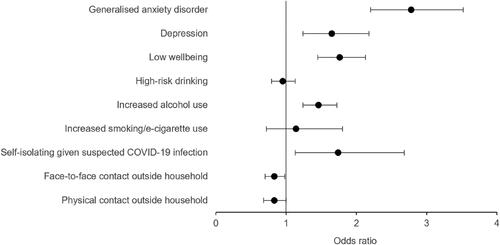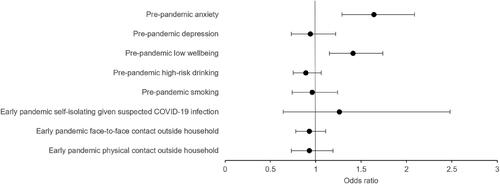Figures & data
Figure 1. Cross-sectional associations between COVID-19 holistic risk perceptions and mental health, wellbeing, and risk behaviours.
Note. Whole sample. Forest plot shows the fully adjusted odds ratios (circles) and 95% confidence intervals (bars). Fully adjusted = adjusted for age, gender, education, keyworker status, pre-pandemic anxiety, depression, high-risk drinking, smoking, and early pandemic suspected COVID-19 infection.

Table 1. Cross-sectional associations between COVID-19 risk perceptions and mental health, wellbeing, and risk behaviours (whole sample).
Table 2. Longitudinal associations between pre-pandemic mental health, wellbeing, and risk behaviours and COVID-19 risk perceptions (whole sample).
Figure 2. Longitudinal associations between pre-pandemic and early pandemic variables and COVID-19 holistic risk perceptions.
Note. Whole sample. Forest plot shows the fully adjusted odds ratios (circles) and 95% confidence intervals (bar). Fully adjusted = adjusted for age, gender, education, keyworker status, pre-pandemic anxiety, depression, high-risk drinking, smoking, and early pandemic suspected COVID-19 infection.

Table 3. Longitudinal associations between early pandemic risk behaviours and COVID-19 risk perceptions (whole sample).
Table 4. Prospective longitudinal associations between mental health and wellbeing polygenic risk scores and COVID-19 risk perceptions.
rjrr_a_2127849_sm0921.docx
Download MS Word (538 KB)Data availability statement
The analysis code is available from the University of Bristol’s Research Data Repository, data.bris, at https://doi.org/10.5523/bris.34bmhh800n6pb25aeva7qucjre. GWAS summary statistics used to create the PRS are available from the original publications. The informed consent obtained from ALSPAC participants does not allow the data to be made freely available through any third party maintained public repository. However, data used for this submission can be made available on request to the ALSPAC Executive. The ALSPAC data management plan describes in detail the policy regarding data sharing, which is through a system of managed open access. Full instructions for applying for data access can be found here: http://www.bristol.ac.uk/alspac/researchers/access/. The ALSPAC study website contains details of all the data that are available (http://www.bristol.ac.uk/alspac/researchers/our-data/).
